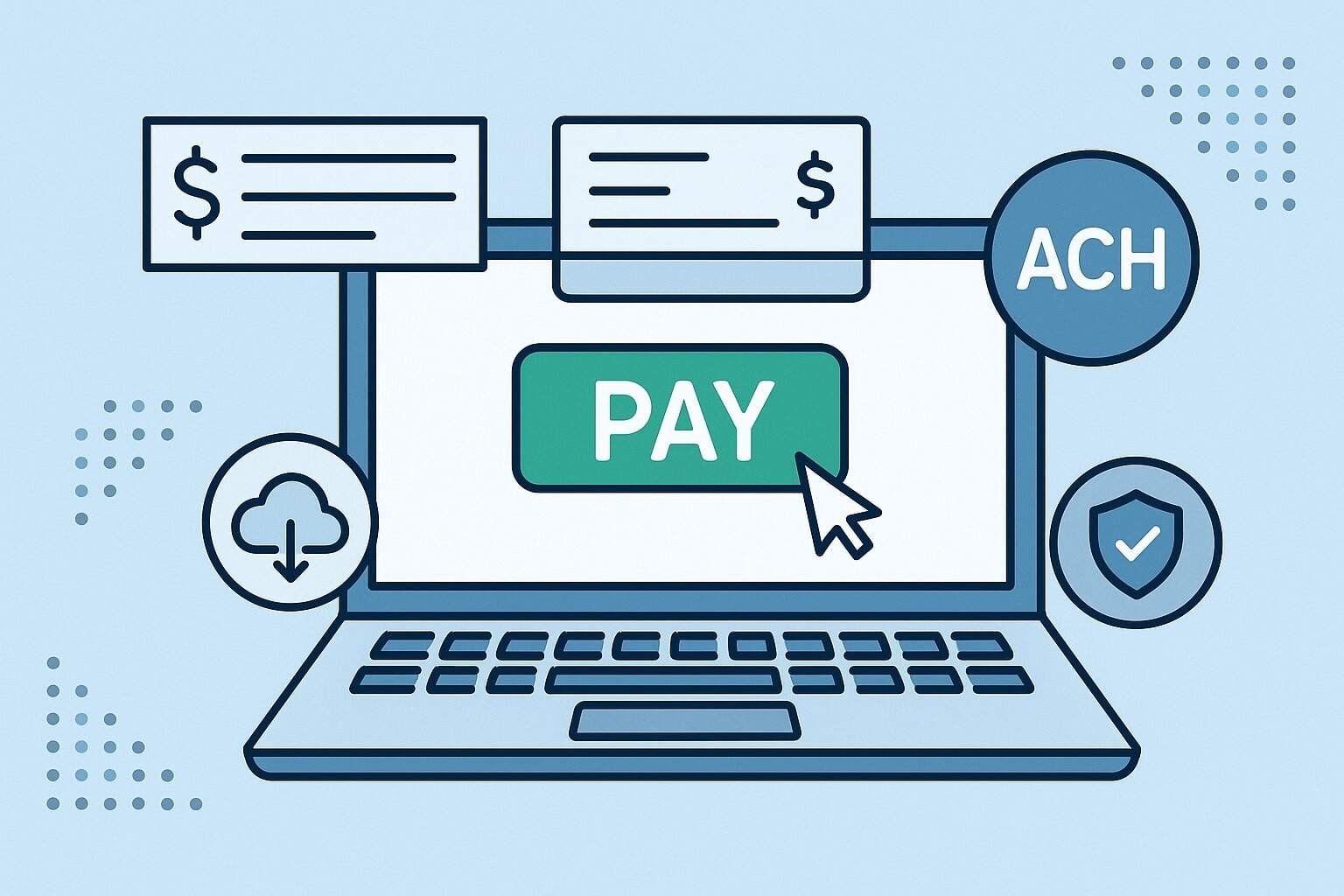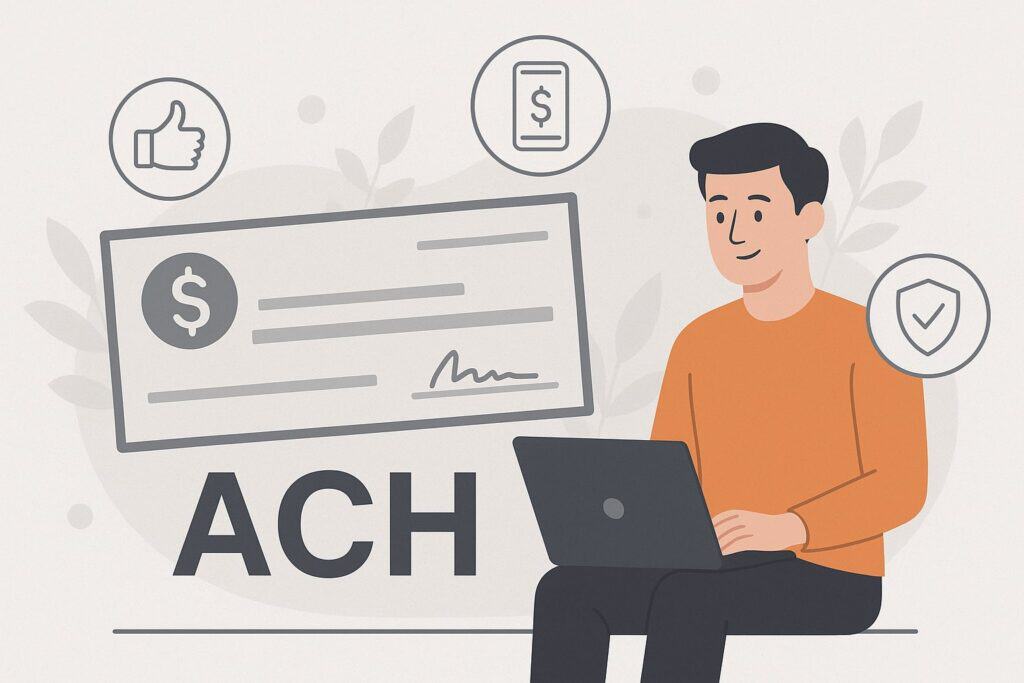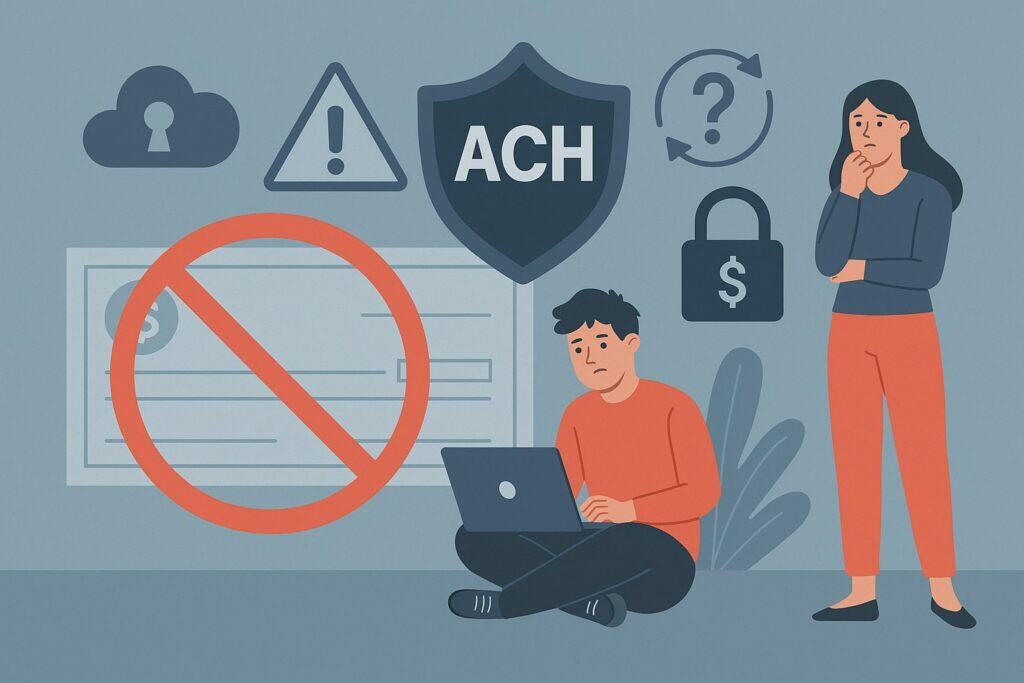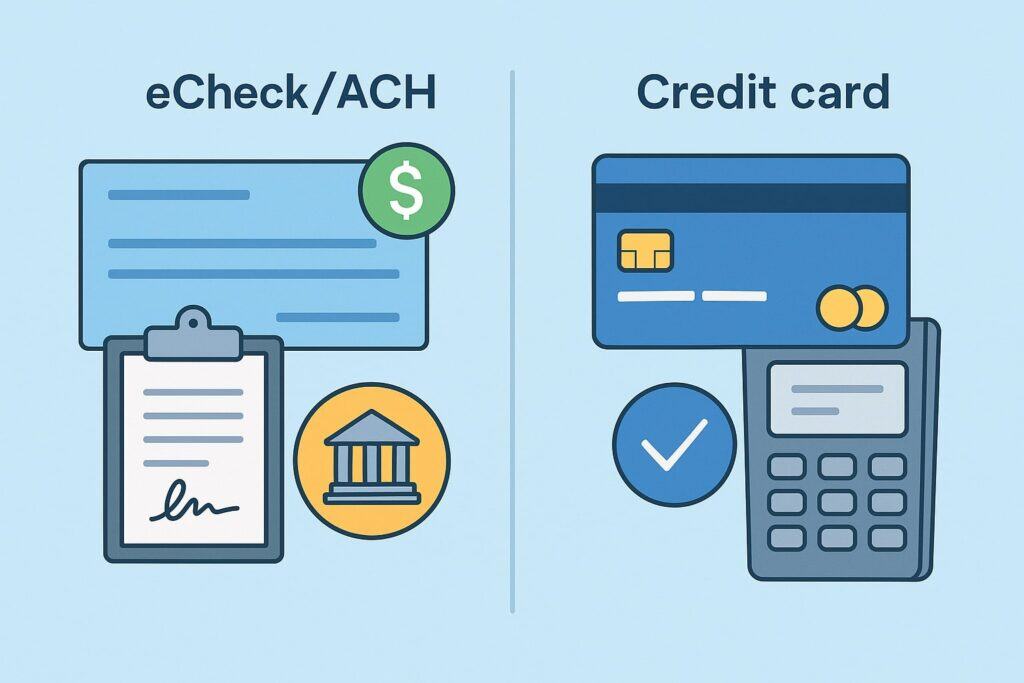
By alphacardprocess October 10, 2025
Accepting eChecks (electronic checks) and ACH payments (Automated Clearing House) online offers businesses a lower-cost, secure, and flexible method for transferring money directly from a customer’s bank account.
In this article, we will explore how these payment methods work, why you should consider them, and step by step how to implement them, along with security best practices, compliance issues, and frequently asked questions.
What Are ACH Payments and eChecks?
When you decide to accept ACH payments or eChecks, it helps to understand exactly what those terms mean, how they relate, and how the processing flows.
The Basics of ACH Payments
ACH stands for Automated Clearing House. It is an electronic network used in many countries (notably in the U.S.) to batch process transactions—direct debits and credits between bank accounts. An ACH payment is a type of electronic funds transfer (EFT) that moves money between bank accounts without using paper checks or card networks.
ACH payments can support:
- Direct debits: e.g. a customer authorizes you to pull money from their account.
- Direct credits: e.g. payroll or disbursements.
Because ACH is structured, regulated, and widely used, it offers automated capabilities, recurring billing, and relatively low fees compared to credit cards.
What Is an eCheck?
An eCheck (electronic check) is essentially a digital version of a paper check, implemented over the ACH network. In practice, the terms “eCheck payment” and “ACH payment” are often used interchangeably.
When the customer provides their bank routing number and account number, and authorizes a transaction, that transaction is processed via the ACH infrastructure. The distinction is that rather than handing over a paper check, the transaction is processed electronically.
Unlike credit/debit card payments, eChecks bypass the card networks, so they avoid card brand interchange fees, making them attractive for businesses—especially for higher dollar or recurring payments.
How ACH and eCheck Interact
When someone “accepts eCheck payments,” that typically means they are leveraging ACH infrastructure to electronically debit a customer’s bank account. The payment flow often looks like:
- The customer authorizes the payment (gives consent).
- Merchant or processor collects bank routing number, account number, amount, date.
- The merchant forwards the transaction to an ACH processor or gateway.
- The ACH network processes the transaction (in batches), sending the debit to the payer’s bank, and credit to the merchant’s bank.
- Funds are settled (cleared) after several business days (commonly 2–5).
- If there are insufficient funds, closed account, or other issue, the transaction may be returned (similar to a bounced check) under ACH return rules.
Because returns can happen after a delay, risk management and verification strategies are crucial.
In short, accepting eChecks is a subset of accepting ACH payments, and as you proceed you’ll see how both are integrated in the broader digital payment ecosystem.
Why Accept eChecks / ACH Payments? — Key Benefits

Before you invest in implementation, it helps to know why accepting eChecks / ACH payments can be beneficial. Here are the principal advantages for merchants:
Lower Transaction Costs
One of the most attractive reasons to accept eCheck / ACH is cost. Because the transaction bypasses credit card networks, merchants avoid interchange and card network fees, relying instead on lower fixed or percentage fees charged by ACH processors.
For many transactions—especially high value ones—the savings can be significant. For example, PaySimple’s ACH payment processing is offered at rates like $0.60 or low percentage per transaction.
Improved Cash Flow Predictability
If your business uses recurring payments (subscriptions, memberships, rent, invoices), ACH provides reliable, automated payments. Once authorization is established, you can debit accounts on schedule, reducing missed payments and manual follow-ups.
You’ll also benefit from batching—processing many ACH transactions together—which improves operational efficiency.
Broader Payment Options & Customer Convenience
By offering eCheck / ACH, you broaden the payment choices for your customers. Some prefer paying directly from bank accounts, especially for large or recurring payments. This flexibility can lead to higher conversion and customer satisfaction.
Because checking account information does not expire like credit cards, you reduce the friction of updating expiring card data.
Enhanced Security and Control
With proper implementation, ACH / eCheck payments can offer robust security, verification, and lower susceptibility to card fraud. Processors often offer account validation, risk scoring, micro-deposits, and fraud filters.
Credit card chargebacks are often more immediate and complex; ACH returns follow defined NACHA rules, and you can manage returns more predictably with risk tools.
Best Use Cases
Some common business scenarios where eChecks / ACH are especially useful include:
- B2B invoices (large ticket payments)
- Subscription / membership models
- Rent or utility billing
- Donations (nonprofits)
- Recurring service contracts
If your business frequently handles large, recurring, or high-value payments, ACH is often the more economical and stable choice.
In sum, the lower cost per transaction, predictability, and flexibility make eCheck / ACH a strong addition to your payments stack.
Challenges & Risks When Accepting eChecks / ACH

Adopting eCheck / ACH is powerful, but it also comes with particular risks and operational challenges. Understanding them allows you to mitigate and manage them.
Return and NSF (Insufficient Funds) Risk
Even if you verify that a bank account exists, the customer’s account may not have sufficient funds when the debit occurs. That can lead to a return. Returns may incur fees, lead to collection costs, or require repeated attempts.
Return rates for ACH can average 1–3%, depending on business type and risk controls.
Fraud & Unauthorized Debits
Fraudsters may attempt to submit unauthorized ACH debits or misrepresent bank account information. Because returns and disputes in ACH processing are more delayed compared to card systems, you must invest in verification and risk scoring tools.
Settlement Delay
Most ACH / eCheck payments take 2-5 business days to settle (i.e. funds arrive). This is slower than some card payments.
You must plan cash flow and not count on instant settlement.
Compliance & Regulation (NACHA Rules, Local Laws)
In the U.S., the NACHA (National Automated Clearing House Association) rules govern ACH processing. You must comply with authorization, recordkeeping, return handling, error correction, and more.
If operating outside the U.S., you will need to understand your country’s regulations governing ACH or equivalent automated bank transfers.
Technical Integration Complexity
Implementing ACH payments requires integration of transaction flows, gateways, APIs, and risk control systems. Poor integration or lack of error handling can lead to failures.
Customer Trust and Hesitation
Some customers may hesitate to share bank routing and account details. To reduce such hesitation, you’ll need strong security branding, encryption, and clear authorization flows.
All said, many of these challenges can be managed or mitigated with good provider choices, solid risk controls, verification tools, and clear user experience design.
Step by Step: How to Accept eChecks / ACH Payments Online
Let’s now walk through, in detail, how a merchant can implement and accept eCheck / ACH payments in their online business.
Step 1: Set Up a Business Bank Account & Financial Infrastructure
Before anything else, ensure your business has a dedicated bank account. This separates personal and business funds, simplifies accounting, and is often a requirement for processors.
Ensure your bank supports ACH transfers and has appropriate arrangements for electronic transfers and deposit credits. Some banks might require special ACH settlement capabilities.
Step 2: Choose an ACH/eCheck Payment Processor or Gateway
You need a processor or payment gateway that supports eCheck / ACH. Not all processors support this, so check features like:
- Support for micro-deposits or instant account validation
- Risk scoring, fraud protection, and return handling
- API / SDK integration options
- Transparent pricing (flat fee, percentage, returns, batch fees)
- Support for recurring billing if needed
- Good documentation and support
Examples include Stripe (via ACH), GoCardless, specialized ACH gateways, or local regional providers.
Step 3: Apply for an ACH Merchant / Payment Account
You will need to fill out an application with the processor, providing:
- Business legal name, address, contact
- Business registration / incorporation documents
- Tax ID / PAN / equivalent
- Bank account details (bank name, routing number, account number)
- Estimated transaction volume, average ticket
- Business website, nature of goods/services
The processor may review risk, business type, and compliance before approving. This process may take several days.
Step 4: Define Authorization & Consent Process
To comply with NACHA rules or local equivalents, you must obtain authorization from the customer before debiting their bank account. This could be:
- Digital agreement or checkbox with their consent
- Signed document or e-signature
- Recorded phone authorization (in some use cases)
You must also keep records of the authorization for audit. You must notify the customer about the schedule, timing, amount, and rights to cancel or dispute.
Step 5: Account Verification & Risk Tools
Before processing larger amounts, verify that the bank account is valid and that it belongs to the customer. Common methods include:
- Micro-deposits: Two small test deposits (e.g. few cents) are posted; customer confirms the amounts.
- Instant account verification APIs: Some providers integrate with bank systems to instantly verify account ownership.
- Bank account validation / routing number checks
Additionally, use risk scoring tools, fraud filters, velocity limits (e.g. number of debits per day), and blacklist suspicious accounts.
Step 6: Implement Gateway / API / Checkout Integration
Integrate the eCheck / ACH payment method into your checkout or billing process. This typically involves:
- Presenting a form to collect routing number, account number, name, authorization checkbox
- Validating input format
- Tokenizing or encrypting bank data
- Submitting transaction via API to the processor
- Handling success / failure callback
- Triggering settlement or retry logic
Many payment gateways provide SDKs or plugins for popular platforms (Shopify, WooCommerce, custom APIs).
Step 7: Batch Submission, Settlement, and Clearing
ACH works in batches. Your processor collects multiple transactions and submits a batch to the ACH network (often daily). After processing, funds are transferred, return items (failures) are flagged, and the net is deposited to your bank account.
You should monitor cut-off times (e.g. 4 PM local time) to ensure transactions are included in the right day’s batch.
Step 8: Return Handling, Retries & Dispute Management
Some transactions will “return” (fail) due to NSF, closed account, or other issues. You must:
- Monitor and manage return reports
- Attempt retries if permissible
- Notify the customer
- Decide whether to refund or collect via other means
- Enforce penalties or fees (if contract allows)
Your processor may provide automated return handling and retry logic.
Step 9: Reconciliation, Reporting, and Accounting
You must reconcile your transaction records with bank statements, mapping which ACH items cleared or returned. Good reporting dashboards can help you track:
- Settlements
- Return rates
- Authorization to debit schedule
- Chargebacks / disputes
- Success rate over time
Integrating with accounting software reduces manual entry and error.
Step 10: Monitor, Optimize, and Scale
After implementation, continuously:
- Monitor return / decline rates
- Adjust risk filters
- Incentivize customers to pay via eCheck
- Optimize cut-off times and batch cycles
- Expand geographic support
- Stay updated on regulation or ACH network changes
By refining and scaling, your ACH / eCheck channel becomes a stable revenue route.
Security, Compliance, and Best Practices
Accepting eCheck / ACH comes with security and compliance responsibilities. Below are crucial best practices and regulatory guidelines to follow.
Data Encryption and Tokenization
Bank account numbers and routing data must be transmitted securely (TLS/SSL). Ideally, sensitive data is tokenized (i.e. replaced with a secure token) so that stored data is non-sensitive.
Never store raw bank account data in plain form.
NACHA / Local ACH Rules
If operating in the U.S., you must comply with NACHA Operating Rules. These rules govern:
- Authorization requirements
- Record retention
- Return and reversal procedures
- Error resolution
- Automated re-presentment
- Third-party sender responsibilities
If you operate internationally, the local ACH equivalent (or direct debit rules) must be followed.
Audit Trails & Recordkeeping
Retain all authorization agreements, payment schedules, change notifications, return reports, refunds, and disputes. These are essential for audits or investigations.
Maintain logs of all API calls and transaction histories.
Customer Disclosure & Transparency
In your authorization agreement or checkout flow, clearly disclose:
- The specific amount(s) to be debited
- Timing (dates, schedule)
- Rights to cancel or dispute
- Contact information
- Return / NSF policies
Full transparency builds trust.
Risk Management & Fraud Tools
Apply fraud prevention measures such as:
- Velocity limits (e.g. no more than X transactions per minute/day)
- Blacklists or repeat offender blocking
- Risk scoring / anomaly detection
- Soft validation (e.g. verify routing number format)
- Micro-deposits or verification before large debits
Retry Logic & Return Mitigation
For failed debits, allow automated retry if allowed, with intelligent delay strategies. Also, notify customers beforehand or immediately after failure to prompt them to take corrective action.
Customer Support & Dispute Handling
Set up robust customer support for disputes, returns, or inquiries. Resolve returns promptly and maintain clear communication to preserve trust.
Regular Audits & Compliance Updates
Periodically audit your processes, security, and compliance status. Track changes in ACH / eCheck infrastructure (e.g. same-day ACH developments) and update your systems.
Differences Between eCheck / ACH and Credit Card Payments

To optimize your payment strategy, it helps to understand how eCheck / ACH compares to credit card transactions in a few key dimensions:
| Dimension | eCheck / ACH | Credit Card Payments |
|---|---|---|
| Fee Structure | Usually lower flat fee + small percentage, no card brand fees | Interchange + network + processor markup, often much higher |
| Settlement / Speed | 2–5 business days (or same-day ACH in some cases) | Often 1–3 business days (or faster) |
| Return / Chargeback Risk | Returns under ACH rules; longer window; lower chargeback complexity | Chargebacks more common; issuers often push disputes aggressively |
| Authorization & Verification | Requires bank account validation, micro-deposits, consent | Card issuer verifies availability, fraud checks, etc. |
| Recurring Payments | Very efficient (account does not expire) | Cards may expire, require updates |
| Customer Tolerance | Some customers wary of sharing bank data | Cards are familiar and widely accepted |
| Complexity / Integration | Needs bank infrastructure, risk management systems | Many plug-and-play card gateways strong in UI |
In general, ACH / eCheck is cost-efficient and suitable for recurring or high ticket payments, while cards are better for instant, small, impulse purchases. Many merchants adopt a hybrid approach, offering both payment methods to cater to customer preference and maximize revenue.
Same-Day ACH and Recent Developments
The ACH network has been evolving to better serve merchant needs. One key development is Same-Day ACH, which allows eligible transactions to settle on the same business day (if submitted by cut-off). This narrows the gap between ACH and card settlement speeds.
If your processor supports it, enabling same-day ACH can reduce waiting times, but usually at a slightly higher fee.
Furthermore, new fintech innovations allow for instant account verification or on-ramp linking to bank accounts, further reducing friction and risk in accepting eCheck / ACH.
As regulatory frameworks evolve, it’s vital to track updates in ACH rules or local equivalents and adapt your system accordingly.
Practical Tips & Optimization Strategies
Here are some additional practical tips to help you make your eCheck / ACH implementation smoother and more effective:
- Offer incentives: encourage customers to pay via eCheck (lower cost to you) by discounting fees or offering small incentives.
- Show security badges: display trust seals and clear statements about encryption and protection to make customers comfortable sharing bank data.
- Use fallback options: if an ACH fails, prompt the customer to use an alternate method (card, wallet) immediately.
- Batch smartly: place transactions before cut-off times to guarantee inclusion in the next batch.
- Segment risk tiers: treat new customers with stricter limits until they establish history.
- Monitor performance metrics: track success rate, return rate, retries, volume, etc.
- Educate your customers: show them how bank routing/account numbers work, where to find them, and reassure them about privacy.
- Scale gradually: start with lower volume or limited use cases (e.g. subscriptions) before opening ACH for all sales.
- Stay updated: follow changes in ACH rules, fee structures, and network enhancements (like same day).
Sample Implementation Flow (Hypothetical Example)
Let’s walk through a condensed example of how an online software-as-a-service (SaaS) business might implement eCheck / ACH payments:
- The business bank account is ready, and the SaaS company selects an ACH gateway (e.g. using an API from a provider).
- The company signs up, submits its paperwork, and activates ACH support.
- On the subscription signup page, customers are shown a bank debit option. They enter routing / account number and check an authorization box that explains payment timing and rights.
- The system triggers a micro-deposit (two small test amounts) to verify the bank account. Once the customer confirms, authorization is accepted.
- For the first subscription billing, the system debits via ACH. If it succeeds, the customer is active. If it returns, a retry is triggered the next day, and email is sent.
- Each night before cutoff, the system pushes pending ACH transactions in a batch to the gateway.
- Over time, the system tracks returns, success rate, and flags suspicious activity if a customer has repeated failed payments.
- The accounting system reconciles settled amounts and returns reports via an integration.
- The business offers a small discount for customers paying via ACH to shift volume to the lower-cost channel.
This kind of stepwise approach helps manage risk and ensure smooth customer experience.
Frequently Asked Questions (FAQs)
Below are common questions merchants ask when setting up eChecks / ACH payments.
Q1. How long does it take for an eCheck / ACH payment to settle?
Answer: Typically, ACH / eCheck payments take 2–5 business days to fully clear and fund your account. With Same-Day ACH, settlement may occur on the same business day if deadlines are met.
Q2. How much does it cost (fees) to accept eChecks / ACH?
Answer: Fees vary by processor, but generally they are lower than credit card fees. You may see a fixed fee (e.g. $0.25 to $1.00) plus a small percentage (e.g. 0.2% to 1.0%). There may also be return fees (for failed transactions), batch fees, or monthly account fees. Always check the fine print of your ACH provider.
Q3. Can I refund an eCheck / ACH payment?
Answer: Yes. If the ACH has cleared, you can issue a refund from your merchant system (or via your processor). If the batch has not yet settled, you may be able to “void” the transaction before settlement depending on your provider.
Q4. Are eChecks / ACH safe?
Answer: Yes, when implemented correctly. Use encryption, tokenization, account verification, fraud filters, and compliance with ACH rules. These safeguards help ensure that your customers’ bank data is not compromised.
Q5. Which processors support ACH / eCheck?
Answer: Many payment processors and fintech firms offer ACH support. Examples include Stripe (ACH), GoCardless, specialized ACH gateways, and regional providers. Check whether they integrate with your tech stack, support verification, and manage returns.
Q6. Can I accept eCheck / ACH payments internationally?
Answer: That depends on the country. The ACH network is U.S.-centric. Other countries use equivalent frameworks (e.g. SEPA in Europe, BECS in Australia). Your provider must support the local banking network.
Conclusion
Accepting eCheck and ACH payments online is a highly efficient, low-cost, and scalable option for many businesses—especially those dealing in subscriptions, large ticket transactions, or recurring billing. While implementation requires care—from authorization, account verification, risk controls, to compliance—when done properly it can reduce costs, improve customer convenience, and offer predictable cash flow.